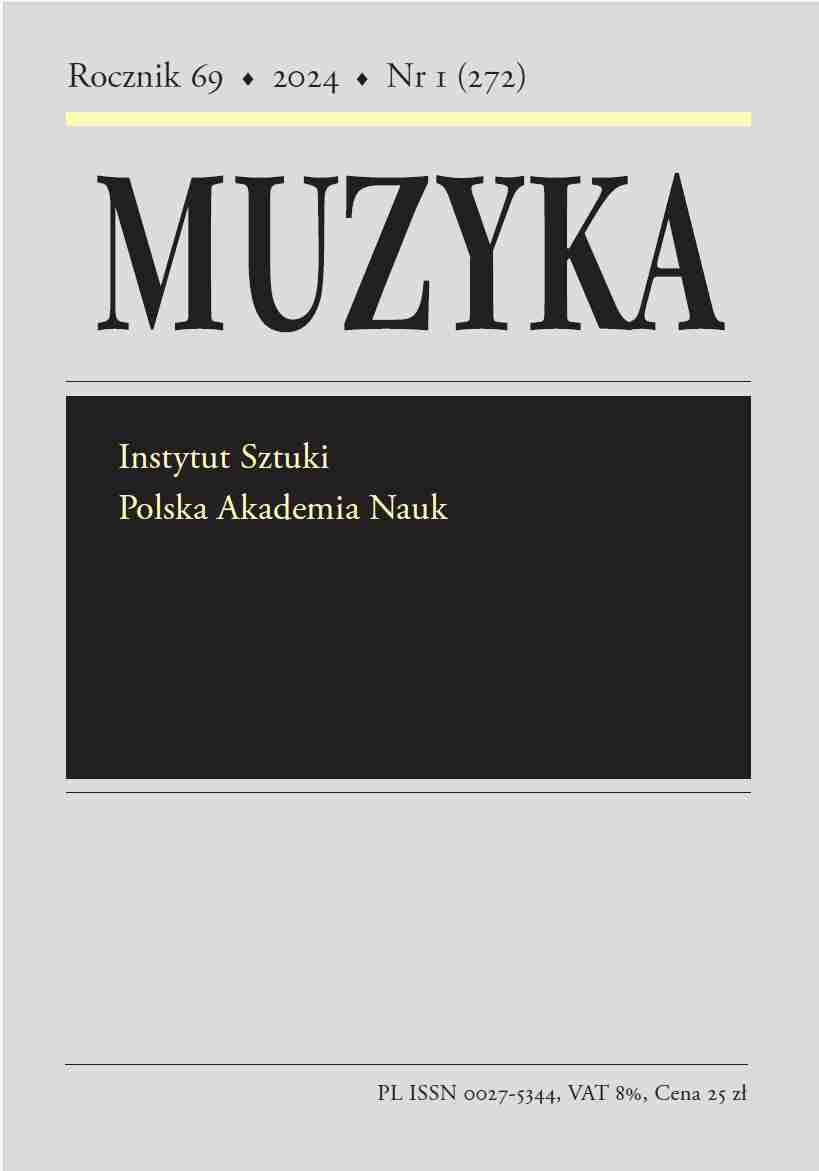'Sancte Simon magno mundi': A newly identified motet by Giovanni Battista Cocciola
Abstract
The article deals with a two-choir motet for nine voice-parts with the incipit Sancte Simon magno mundi, preserved in the form of an organ intabulation included in the Oliwa (Braniewo) Tablature, started in 1619 (Vilnius, the Wróblewski Library of the Lithuanian Library of Sciences, F 15-284, f. 45v–46r), and attributed to a “Joannis Baptista”. In this source, and in similar sources from the northern territories of the First Polish Republic, such concise attributions referred only to composers well-known locally; also, in the case of two manuscripts, the names “Joannes Baptista” were used with reference to Giovanni Battista Cocciola, a composer based in Warmia and the Grand Duchy of Lithuania (years of activity confirmed in the sources: 1606–25). The author offers a summary of available knowledge about the composer’s artistic legacy, adding new information, including the previously unnoticed reference to the existence of another authorial print that has not survived (Motetti a cinque, ed. before 1621). The text of the motet Sancte Simon magno mundi has not been found. The text certainly refers to the apostle Simon the Zealot, who was not worshipped individually on a large scale, but was the patron saint of Szymon Rudnicki, Bishop of Warmia in the years 1605–21. Rudnicki maintained close contacts with the Jesuit College in Braniewo, where the source of the motet discussed here originated, and Cocciola was recorded as a musician in the bishop’s service in 1606. This remarkable coincidence lends credibility to the speculation that the motet Sancte Simon magno mundi could have been authored by Cocciola, who probably dedicated the composition to his patron.
The motet belongs to a relatively small group of compositions in which the melody of the appeal from the Litany of Saints was used as an ostinato. The piece reveals a close affinity to Antonio Gualtieri’s motet Beatissimus Marcus for the same set of performers, published in an authorial print in 1604. In both compositions, the ostinato in the highest voice-part is repeated seven times without variations and at equal intervals. Gualtieri’s motet is also about a saint with the same name as the composer’s patron, Bishop Marco II Cornaro, to whom the collection was dedicated. It seems highly probable that Cocciola consciously modelled his composition on Gualtieri’s motet, while applying more sophisticated artistic devices: an ostinato performed at three different levels of the scale, an opening in imitative technique, greater variation of rhythm, the absence of repeated material and a more impressive culmination at the end.
Keywords:
Polish music, seventeenth-century music, Giovanni Battista Cocciola, Braunsberg-Oliva tablature, Szymon Rudnicki, Antonio Gualtieri, ostinato motetStatistics
Abstract views: 453PDF downloads: 621
License
Copyright (c) 2018 Muzyka

This work is licensed under a Creative Commons Attribution-NonCommercial-NoDerivatives 4.0 International License.
The author grants the publisher a royalty-free nonexclusive licence (CC BY 4.0) to use the article in Muzyka, retains full copyright, and agrees to identify the work as first having been published in "Muzyka" should it be published or used again (download licence agreement). By submitting an article the author agrees to make it available under CC BY 4.0 license.
Articles from 2018/1 to 2022/3 were published under a Creative Commons license CC BY-NC-ND 4.0. During this period the authors granted the publisher a royalty-free nonexclusive license (CC BY-ND 4.0) to use their article in "Muzyka", retained full copyright, and agreed to identify the work as first having been published in our journal should it be published or used again.
Most read articles by the same author(s)
- Marcin Szelest, A Contribution to the Study of the Work and Output of Musicians Active at the Royal Court of the Polish-Lithuanian Commonwealth in the Second Half of the Sixteenth Century , Muzyka: Vol. 67 No. 4 (2022)
- Marcin Szelest, A ‘Psalm of David’ and Other Intabulations of Vocal Contrafacta in Late Sixteenth- / Early Seventeenth-Century Organ Manuscripts Compiled in the Polish–Lithuanian Commonwealth , Muzyka: Vol. 68 No. 1 (2023)
- Marcin Szelest, Newly discovered fragments of Wacław of Szamotuły’s 'Lamentationes': A contribution to interpreting the source , Muzyka: Vol. 63 No. 1 (2018)
- Marcin Szelest, A New History of the Gdańsk/Danzig Organ Tablature , Muzyka: Vol. 69 No. 4 (2024)
- Marcin Szelest, In defence of Podbielski’s ‘Praeludium’ , Muzyka: Vol. 62 No. 1 (2017)
- Marcin Szelest, The History of Twentienth-Century Annotations in the Lost Keyboard Tablature Manuscript from the Holy Spirit Monastery in Kraków and the Chronology of its Photocopies , Muzyka: Vol. 69 No. 4 (2024)
- Marcin Szelest, An Unknown Letter of Paul Siefert and his Activities until 1611 , Muzyka: Vol. 70 No. 3 (2025)










